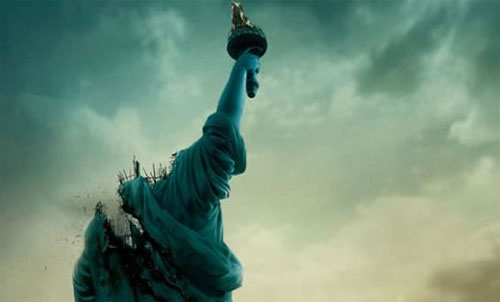
Cloverfield
Though he neither wrote nor directed it, producer J.J. Abrams’s stamp is all over Cloverfield, the newest entry in the monster movie annals. From the brilliant trailer and advertising campaign that began, simply, with 1-18-08, Abrams has fashioned Cloverfield as a near-perfect example of what he calls “The Mystery Box.”
For Abrams, the Mystery Box, which you can see him explain in his entertaining TED Talk, is all about anticipation and expectation. J.J.‘s Mystery Box is one of three things: 1) It’s the teaser, the big question: What is this about? Who is that? 2) It’s about intentionally withholding information: The Sixth Sense. The last scene in Lost in Translation. The shark in Jaws. 3) It’s about what you think you’re getting versus what you’re really getting. Misdirection. J.J. actually has a real Mystery Box, and it’s never been opened. He says it represents “true potential,” which means, in a sense, you can only be disappointed when you open it. Which is why Cloverfield, written by Buffy/_Alias_/_Lost_ scribe Drew Goddard and directed by Matt Reeves, is the perfect embodiment of the Mystery Box.
The lead-up (I refuse to use the word hype) for this movie, from the sneaky fake websites to the brilliant teaser trailer all the way down to the poster, was so intriguing, so wonderfully mysterious, that the movie itself can only be a letdown. This is not to say it’s a bad movie by any means, but like whatever actually lies inside that Mystery Box, it’s never quite as good as what might be in there.
For a letdown, the film is actually quite entertaining, and that is due largely to the frenetic immediacy of the camera work. The film’s central conceit is, much like that of The Blair Witch Project, that it was based on footage shot by its characters. In fact, the film begins with the following message:
Multiple sightings of case designate “Cloverfield”
camera retrieved at incident site U.S. 447
area formerly known as “Central Park”
The camera in question belongs to Rob Hawkins (Michael-Stahl David), a young, hip New Yorker on his way to Japan for a big promotion. His friends throw him a surprise going away party, and his best buddy, Hud (T.J. Miller) gets stuck capturing the evening and inducing goodbyes and testimonials by all the party goers. But when the melodrama of 20-something life is interrupted by rumbling and then eventually explosions off in the distance, Hud becomes our de facto narrator for a tale of survival.
Once the Statue of Liberty head rolls to a stop in the middle of a Lower East Side street—and all the gawkers pull out their cameras and cell phones to capture the moment in all its low-resolution glory—the movie becomes a prototypical journey film. The focus quickly shifts to a group of core characters: Rob, Hud, Rob’s brother Jason, Jason’s girlfriend Lily, and Hud’s crush Marlena (Lizzy Caplan, probably the only actor anyone is likely to recognize), who band together to first escape Manhattan, then to foolishly trek back uptown to save Rob’s friend-turned-true-love Beth (Odette Yustman). The path to Beth is fraught with difficulty, to say the least, and the characters are down right idiotic in their quest, but monster/horror/action movies need stupid people to keep the story going.
Eventually we come to the requisite scenes of carnage, both small and large in scale. The military shows up, both in attack mode and rescue mode, yet isn’t very successful at either. Characters drop off like flies, some times more unexpected than others, though in truth we shouldn’t be all that surprised given the message at the opening of the movie. Despite all this, Cloverfield transcends these formulaic roots at times. The vivid handheld style—which inspires a ticket booth warning of motion sickness—is thrillingly there. Filmed at “ground level,” and often showing accidental moments (the camera is momentarily dropped, the footage slips back to an old recording on the same tape) that amp up the “reality,” the movie takes you on a thrill ride that—much like if you were to turn the lights on at Space Mountain—might not be that thrilling otherwise. But you know what? Space Mountain is still my favorite Disneyland roller coaster. And as the closing credits (sadly, I didn’t stay until the absolute end) roll on Cloverfield, any feelings of disappointment were nowhere to be found, and I was left only with satisfaction.
Grade: B
